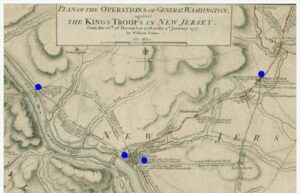Princeton Battlefield and Clarke House
 Built in 1772, in the middle of what was then a 200-acre farm, the historic Clarke House is in outward appearance simply a white clapboard farm house. This historic building is central to the Battle of Princeton, fought on January 3rd, 1777, between the Continental Army under the command of General George Washington and British Crown forces.
Built in 1772, in the middle of what was then a 200-acre farm, the historic Clarke House is in outward appearance simply a white clapboard farm house. This historic building is central to the Battle of Princeton, fought on January 3rd, 1777, between the Continental Army under the command of General George Washington and British Crown forces.
The Clarkes, a third-generation Quaker family of the Stony Brook Quaker Settlement, turned the house into a field hospital after the battle, taking in both British and American wounded. Despite being cared for by Dr. Benjamin Rush (signer of the Declaration of Independence), American General Hugh Mercer died here nine days after the battle from being shot and bayoneted. Mercer County in New Jersey, site of the battle, is named in his honor.
On the grounds of the battlefield stands the Mercer Oak. Legend has it that General Hugh Mercer was laid against the original Mercer Oak when he was shot and bayoneted during the Battle of Princeton. It has been immortalized in the famous painting, “The Death of General Mercer at the Battle of Princeton January 3, 1777”, by John Trumbull. Today, standing proudly and majestically on the Princeton Battlefield is a descendant of the Mercer Oak, which collapsed of old age in 2000.
The Ionic Colonnade that graces the western side of the battlefield park stands near the original location of the home of William Clarke, one of the brothers who farmed the surrounding land at the time of the battle. The columns and lintel actually originated as the portico of the mansion of Philadelphia merchant Matthew Newkirk, who had commissioned Thomas Walter, later the designer of the dome of the U.S. Capitol, for its construction. When Newkirk’s home was demolished around 1900, the colonnade was salvaged and transported to Princeton to become the entrance of Mercer Manor, another distinguished home that stood on the edge of the battlefield until it was destroyed by fire in the 1950s. At that time, the Institute for Advanced Study owned the property and donated its portico to the State of New Jersey. The Colonnade was dedicated where it stands in 1959, and declared a National Historic Monument in 1962.
The Colonnade is more than an architectural curiosity, though, since it is placed to serve as both an entrance and marker for the gravesite of fallen soldiers that lies nearby. A plaque on the portico notes:
“In the memorial grove beyond you, those who fell in the Battle of Princeton, both American and British, lie buried. The historic portico in which you stand was re-erected here to mark the entrance to the tomb of these unknown soldiers of the Revolution”
The memorial was erected in 1918, in memory of the thirty-six unknowns buried here, including fifteen American and twenty-one British soldiers. The words engraved on the tablet are those of Alfred Noyes (1880 – 1958), taken from his poem “Princeton” (1917). Noyes was a visiting professor at Princeton University, and later became Poet Laureate of England. He wrote his poem 140 years after the battle, at a time when American and British soldiers were fighting together in support of their common heritage of freedom. The opening lines of the poem are quoted on the plaque:
“Here Freedom stood by slaughtered friend and foe,
And, ere the wrath paled or that sunset died,
Looked through the ages; then, with eyes aglow,
Laid them to wait that future, side by side.”
The Colonnade can be considered a fitting tribute both to the brave Americans who fell at Princeton and, by echoing the artistry of ancient Greece, a reminder of the long history of the ideals of freedom and self-government for which they fought.


